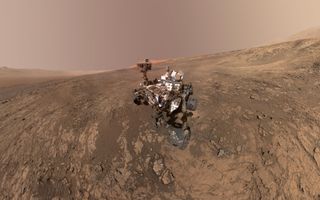
Some aspects of the Mars methane mystery are starting to clear up.
Since landing inside the Red Planet's Gale Crater in 2012, NASA's Curiosity rover has repeatedly detected methane — a background level of less than 0.5 parts per billion (ppb) molecules of air, with some puzzling surges up to 20 ppb.
Those measurements, made with the Tunable Laser Spectrometer (TLS) instrument in Curiosity's Sample Analysis at Mars (SAM) chemistry lab, are intriguing to astrobiologists, because methane is a possible biosignature gas. The vast majority of methane in Earth's air, after all, is generated by microbes.
The search for life on Mars: A photo timeline
The gas can also be produced abiotically, however — via the interaction of hot water with certain types of rock, for example — so scientists still aren't sure where the Martian methane is coming from. And there has been an additional complication in their interpretation of the TLS data as well.
That complication is the non-detection of methane higher up in the atmosphere by the European Space Agency's Trace Gas Orbiter (TGO), part of the European-Russian ExoMars exploration program. As its name suggests, TGO was designed to sniff out low-abundance gases, methane chief among them.
"When the Trace Gas Orbiter came on board in 2016, I was fully expecting the orbiter team to report that there's a small amount of methane everywhere on Mars," TLS lead scientist Chris Webster, who's based at NASA's Jet Propulsion Laboratory in Southern California, said in a statement. "But when the European team announced that it saw no methane, I was definitely shocked."
Get the Space.com Newsletter
Breaking space news, the latest updates on rocket launches, skywatching events and more!
In 2019, researchers led by Curiosity team member John E. Moores, a planetary scientist at York University in Toronto, proposed a possible answer.
Because TLS is such a power-hungry instrument, Curiosity makes its methane measurements at night, when most of the rover's other science gear is dormant. But TGO needs sunlight to spot methane and therefore does its sniffing during the day. Perhaps that difference is the key variable, Moores and his colleagues suggested in their 2019 study: Maybe methane seeps out of Gale's floor at night, building up to levels detectable by Curiosity, but is diluted so much during the day by atmospheric mixing that TGO cannot pick it up.
The Curiosity team decided to test this idea, taking high-precision daytime measurements with TLS for the first time over the course of one day last year. The researchers sandwiched those observations with nighttime readings and found that Moores' idea appears to be on the money.
"John predicted that methane should effectively go down to zero during the day, and our two daytime measurements confirmed that," SAM principal investigator Paul Mahaffy, of NASA's Goddard Space Flight Center in Greenbelt, Maryland, said in the same statement. "So that's one way of putting to bed this big discrepancy."
Mahaffy and his team, which includes Moores, reported their results in a new study, which was published this week in the journal Astronomy & Astrophysics.
There are more Mars methane mysteries to tackle, of course. There's the origin question, for starters. It also appears that something may be destroying methane in Mars' atmosphere faster than scientists had predicted. (Solar radiation should, on average, rip each methane molecule apart after about 300 years in Mars' air.)
If methane is seeping from the ground all over the planet, and not just at Gale, the gas should accumulate to levels detectable by TGO despite atmospheric mixing, the researchers said.
"We need to determine whether there's a faster destruction mechanism than normal to fully reconcile the data sets from the rover and the orbiter," Webster said.
Mike Wall is the author of "Out There" (Grand Central Publishing, 2018; illustrated by Karl Tate), a book about the search for alien life. Follow him on Twitter @michaeldwall. Follow us on Twitter @Spacedotcom or Facebook.
Join our Space Forums to keep talking space on the latest missions, night sky and more! And if you have a news tip, correction or comment, let us know at: community@space.com.

Michael Wall is a Senior Space Writer with Space.com and joined the team in 2010. He primarily covers exoplanets, spaceflight and military space, but has been known to dabble in the space art beat. His book about the search for alien life, "Out There," was published on Nov. 13, 2018. Before becoming a science writer, Michael worked as a herpetologist and wildlife biologist. He has a Ph.D. in evolutionary biology from the University of Sydney, Australia, a bachelor's degree from the University of Arizona, and a graduate certificate in science writing from the University of California, Santa Cruz. To find out what his latest project is, you can follow Michael on Twitter.
Most Popular


